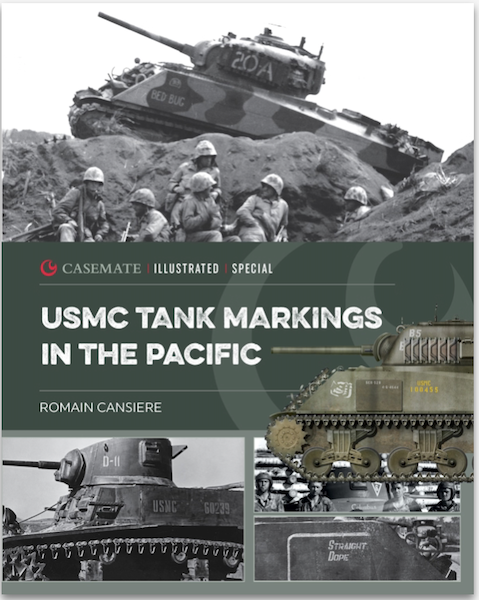USMC Tank Markings in the Pacific
Publisher’s Notes
The markings on tanks of the United States Marine Corps during World War II are so varied that some have concluded they were meaningless, even anarchic. Official documents offer little insight, but a careful study of period photographs and film, cross-referenced with combat reports and veteran accounts, reveals the different systems of markings that combat units used to identify their vehicles. These markings varied between units, and from one campaign to the next, but were well-thought-out and designed to be practical and easy for tankers to interpret. In addition to tactical markings, most tankers were given names by their crews, and these were added to the tank’s markings. Personifying the tank often boosted crew morale and led to even more careful maintenance of the tank. Names were approved by tank commanders, and also followed systems that aided quick identification in combat.
Illustrated with numerous period photographs and detailed color profiles, this book explains the markings used by USMC tank combat units during the Pacific War, from 1942 to 1945. each chapter details one unit, covering markings down to section level and showing how the markings and names changed through that unit’s campaigns.
- Chapter 1 - 1st Tank Battalion
- Chapter 2 - The Tank Sections of the Defense Battalions
- Chapter 3 - 1st Corps Tank Battalion (Medium)
- Chapter 4 - 2nd Tank Battalion
- Chapter 5 - 3rd Tank Battalion
- Chapter 6 - Tank Company, 4th Marines
- Chapter 7 - 2nd Separate Tank Company/Tank Company, 22nd Marines
- Chapter 8 - 4th Tank Battalion
- Chapter 9 - 5th Tank Battalion
- Chapter 10 - 6th Tank Battalion
- Appendices
- Structure and Organization of Marine Corps Tank Units
- Markings for Aerial Observers, 1943-1945
- History of the Marine Corps Armored Corps
- The Marine Corps Campaigns in the Pacific
Romain V. Cansière is a native of southern France, interested in the U. S. Marine Corps since his teenage years. His current historical research is on the Marine Corps in World War I.
Oscar and Romain co-authored Tanks In Hell: A Marine Corps Tank Company On Tarawa, winner of the 2016 General Wallace M. Greene Jr. Award for distinguished non-fiction.
Reviewer’s Comments
If you are interested in World War II armor and markings, you’ll really love this book. This book is a treasure trove for those interested in Marine Corps armor across the numerous bloody battles of the Pacific theater. Within the 160 pages of USMC Tank Markings in the Pacific, the reader is carried across the battles in a very well researched and written history of the Pacific islands combat. In this significant historical account, the author covers each of the island-hopping efforts, with the battalions and companies with their individual organizations and tank names identified. While the reasoning and planning behind which islands were chosen as the targets and those to be avoided is hinted at, Admiral Nimitz, Admiral Halsey and General MacArthur’s strategy is evident throughout the book’s overall narrative.
The author uses a wealth of photographs (with many period color images) to illustrate the combat and many names of individual tanks within each battalion. And the ‘cherry on the top’, are full-color rendered illustrations of several dozens of the tanks. I have attached a number of thumbnail scans to provide you with a of these illustrations to give you a sense of previously unknown camouflage schemes and patterns.
This book is also a fantastic research tool for those of us who enjoy scale modeling. It unleashes several new specific avenues for modeling possibilities, including new camouflage patterns and colors, as well numerous tank names and markings.
While I had long been interested in the Pacific campaign until this book, I simply had no idea of the breath or number of tanks used by the Marine Corps. The tank images also included a sizable number of M3, M5 and M4 tanks, including many photographs of them, both destroyed and in operable condition. As another historical note, I lived on Saipan from 1947 to 1949 and spent much of my early childhood exploring many caves and several tanks in the then beautiful sandy beaches.
Summary
I wish to express my sincere gratitude for the opportunity to review this book to Casemate Publishers and to IPMS/USA for the opportunity to review it. It combines three essential aspects of the Pacific World War II history: (a) a well-researched and written narrative describing the island-hopping campaign in the Pacific theater, (b) more than 150 period photographs, and (c) beautifully rendered color drawings illustrating a variety of paint schemes and camouflage patterns.
Mr. Cansière has provided a wealth of information for modelers and others interested in the history of the Marine Corps and Navy’s Pacific campaign.











Comments
Add new comment
This site is protected by reCAPTCHA and the Google Privacy Policy and Terms of Service apply.
Similar Reviews